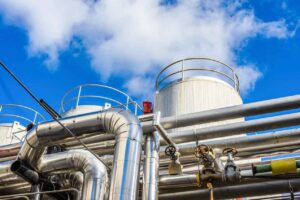Gas analyzer is an instrument widely used in scientific research, industrial production, environmental monitoring and other fields. They can be used to measure various gas components in the air to help people understand air quality, chemical reaction processes, and gas emissions in industrial production. With the continuous advancement of technology, gas analyzers have also undergone many improvements and developments. One of the most significant advancements is the emergence of portable gas analyzers. This article will explore the development history, application areas and challenges of portable gas analyzers.
The development history of portable gas analyzers
Gas analyzers were originally large instruments used for laboratory research, often requiring specialized laboratory conditions and operators. However, as the demand for gas analysis continues to increase, researchers and engineers are looking for more convenient and flexible solutions. The concept of portable gas analyzers was born.

In the early 20th century, the first portable gas analyzers began to appear. They are typically smaller and lighter than traditional laboratory instruments but have limited performance and can only measure a few gas components. As technology continues to advance, portable gas analyzers are becoming more powerful and capable of measuring more types of gases and providing more accurate data.
In the 1980s and 1990s, the rapid development of electronic technology provided opportunities for further improvements in portable gas analyzers. Improvements in microprocessors, sensor technology, and data processing capabilities have enabled portable gas analyzers to achieve greater accuracy and stability. In addition, with the application of advanced technologies such as infrared spectroscopy and mass spectrometry, the detection capabilities of portable gas analyzers have been significantly improved.
Types and characteristics of portable gas analyzers
There are many types of portable gas analyzers, each with different features and application areas. Here are some common types of portable gas analyzers and their characteristics:

1. Spectrometer
A spectrometer is a common portable gas analyzer, They use different wavelengths of light to measure the absorption or emission properties of gases. The most common types are infrared spectrometers and UV-visible spectrometers. They have the following characteristics:
- High Accuracy: Spectrometers typically have high accuracy and sensitivity and are capable of measuring low concentrations of gas components.
- Multi-gas analysis: They can measure multiple gases simultaneously, making them suitable for applications requiring multi-gas analysis.
- Non-destructive: Spectrometers are generally non-destructive and do not require direct contact with the sample gas.

2. Electrochemical sensors
Electrochemical sensors are another common type of portable gas analyzer that measure gas concentration based on a chemical reaction between the gas and an electrode. Their features include:
- Fast response: Electrochemical sensors typically have fast response times, making them suitable for applications requiring immediate monitoring, such as security detection.
- Low cost: Electrochemical sensors generally have low manufacturing costs relative to other technologies.
- Portability: They are usually very small and lightweight, making them easy to carry to the field for measurements.
3. Mass spectrometer
A mass spectrometer is an advanced gas analysis instrument. They determine gas composition by measuring the mass and fragmentation of gas molecules. Their features include:
- High Resolution: Mass spectrometers have excellent resolution and are able to accurately determine the mass of gas components.
- Versatility: They can be used to analyze a variety of gases, including organic compounds, inorganic gases, and trace gases.
- Complex operation: Mass spectrometers generally require higher operating skills and maintenance costs and are suitable for demanding scientific research and industrial applications.

4. Gas detection tube
Gas detector tubes are simple and affordable portable gas analyzers that use adsorbents and reactive reagents to measure gas concentrations. Their features include:
- Ease of use: Gas detection tubes are generally very easy to use and do not require complicated operating procedures.
- Single gas analysis: Each detector tube is typically designed to measure a specific gas, making it suitable for applications requiring single gas analysis.
- Limited Accuracy: They generally have low accuracy and are suitable for general surveillance and preliminary screening.
Different types of portable gas analyzers have advantages and limitations, and choosing the right instrument depends on your specific application needs and budget. When selecting and using a portable gas analyzer, users need to carefully consider the instrument’s features to ensure that their measurement objectives are met.
| Gas analyzer type | principle | Features | advantage | Application areas |
| spectrometer | Light absorption or emission properties | High precision, multi-gas analysis, non-destructive | High sensitivity and accuracy, versatile | Environmental monitoring, industrial production, scientific research |
| Electrochemical sensors | Chemical reaction potential changes | Fast response, low cost, portable | Low cost, fast response, suitable for immediate monitoring | Safety testing, environmental monitoring, medical applications |
| mass spectrometer | Mass and fragmentation of gas molecules | High resolution, multi-purpose, complex operation | High accuracy, suitable for various gases, high resolution | Scientific research, environmental monitoring, industrial quality control |
| Gas detection tube | Adsorbents and Reagents | Easy to use, single gas analysis, limited accuracy | Simple, cost-effective, no complicated steps required | Initial screening, general surveillance, emergency response |
Application areas of portable gas analyzers
The wide range of application areas of portable gas analyzers include but are not limited to the following aspects:
1. Environmental monitoring: Portable gas analyzers can be used to detect various pollutants in the air, such as particulate matter, harmful gases and volatile organic compounds. This is critical for environmental monitoring and air quality management.
2. Industrial production: In industrial production, portable gas analyzers can be used to monitor gas emissions during the production process to ensure compliance with environmental regulations and safety standards.

3. Safety detection: Portable gas analyzers also play an important role in the field of safety detection. For example, in the transportation of dangerous goods, they can be used to detect leaks of dangerous gases and help take necessary emergency measures.
4. Medical applications: In the medical field, portable gas analyzers are used to detect oxygen and carbon dioxide concentrations in respiratory gases to help doctors monitor patients’ respiratory functions.
5. Scientific research: Scientific researchers use portable gas analyzers to conduct experiments and take samples to study the properties and interactions of different gases.
Portable Gas Analyzer Challenges
Although portable gas analyzers have made significant progress in various fields, they still face some challenges:
1. Accuracy and sensitivity: Portable gas analyzers are generally not as accurate and sensitive as laboratory instruments. In some applications, higher accuracy is required to ensure accurate measurement results.
2. Multi-gas measurement: Some environmental and industrial applications require the simultaneous measurement of multiple gases, which poses a challenge to portable gas analyzers because the measurement methods and technologies for different gases may be different.
3. Calibration and maintenance: Portable gas analyzers require regular calibration and maintenance to ensure their performance and accuracy. This may add additional cost and effort to the user.
4. Data processing and transmission: With the advancement of data processing and transmission technology, portable gas analyzers need to be able to efficiently process and transmit measurement data to make timely decisions.
5. Power supply and continuous runtime: Portable gas analyzers often require battery power, so battery life and power management are also important considerations, especially in applications in the field or remote areas.
Conclusion
The emergence of portable gas analyzers provides greater flexibility and convenience for gas analysis, making it widely used in various application fields. However, continuous technological improvements and innovations are still needed to overcome challenges in accuracy, multi-gas measurement, data processing, etc. With the continuous development of science and technology, portable gas analyzers will continue to provide us with more accurate and reliable gas analysis data, helping to better protect the environment, ensure the safety of industrial production, and support the progress of scientific research.

























